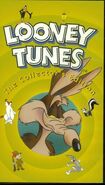Tweetie Pie is a 1947 Merrie Melodies short directed by Friz Freleng.
Title[]
The title is a play on the term of endearment "sweetie pie," and also a play on Tweety's own name
Plot[]
Thomas captures Tweety, whom he finds outside in the snow, warming himself by a lit cigar. The cat's mistress, whose face is never shown, saves the bird from being eaten by the cat, whom she promptly reprimands.
Tweety is brought inside, and the mistress warns Thomas not to bother the bird. Ignoring this command, Thomas initiates a series of attempts to get Tweety from his cage such as stacking up furniture and tables as a ladder, each ending in a noisy crash thanks to Tweety foiling his plans to eat him, bringing the lady of the house to whack Thomas with a broom every time.
Next, Thomas uses the table fan as a propeller to fly himself upwards Tweety's cage, but Tweety immediately unplugs the fan, causing Thomas to fall down on the floor hard. Afterwards, when Thomas tries using a fishing line to raise himself up to grab Tweety, Tweety immediately yells for help at the noisiest volume to alert the mistress, causing Thomas to panic, lower himself back to the ground, and fake being asleep to fool her. When it turns out she never responded, incensed, Thomas ambushes Tweety while he's singing a little song to himself, somehow getting inside Tweety's cage, and trapping Tweety in a soundproof glass cup. Thomas thinks he got one over on Tweety as he smiles smugly, but when he looks back at Tweety, his smug smile changes to a horrified look as Tweety intends to prick his palm with a pin to force him to release him. Thomas frantically shakes his head in panic, but Tweety, in self-defense, does it anyway, sending Thomas shooting towards the ceiling with a drawn-out pained shout of "YEOW!!!", allowing Tweety to make enough of a racket to alert the mistress, who this time hears him and catches Thomas red-handed as he frantically pleaded for Tweety to stop, resulting in the mistress, who has finally had enough of Thomas ignoring her commands to stop eating Tweety, to throw him out into the cold as punishment after whacking him with her broom once more, with Thomas resigning himself to his fate.
The cat tries to get back into the house through the chimney. Tweety puts wood in the fireplace, pours gasoline on it and lights it. The explosion sends Thomas flying right back up the chimney and into a bucket of frozen water.
However, Thomas gets back in the house via a window in the basement and creates a Rube Goldberg-esque trap to capture Tweety, which of course, backfires and injures him instead. Finally, Thomas tries to capture Tweety by running up to the attic and sawing a hole around Tweety's cage, but he ends up causing the entire inner ceiling to collapse (sans Tweety's cage, which is being held in place by a beam). The faux pas creates such a racket that Thomas is sure the mistress will come downstairs and wallop him again, and so, he takes her broom, breaks it in half, and tosses the pieces into the fire. This proves to be a bad move, as he finds himself being walloped on the head repeatedly with a shovel...by Tweety, calling him a "bad ol' puddy tat!".
Availability[]
(Associated Artists Productions print)
Viddy-Oh! For Kids Cartoon Festivals The Best of Bugs Bunny & Friends
Viddy-Oh! For Kids Cartoon Festivals Little Tweety and Little Inki Cartoon Festival Featuring "I Taw a Putty Tat"
Cartoon Moviestars: Tweety and Sylvester
The Golden Age of Looney Tunes Volume 1, Side 6, Friz Freleng
The Golden Age of Looney Tunes Volume 6, Friz Freleng
Looney Tunes: The Collectors Edition Volume 15: A Battle of Wits (1995 USA Turner Dubbed Version)
Tweety & Sylvester (2003)
Looney Tunes Golden Collection Volume 2, Disc Three
Looney Tunes Spotlight Collection: Volume 2, Disc 1
Warner Bros. Home Entertainment Academy Awards Animation Collection, Disc 1 (restored without DVNR)
Looney Tunes Platinum Collection: Volume 1, Disc One
Tweety Pie
Sylvester
Looney Tunes Platinum Collection: Volume 1, Disc One
Looney Tunes Showcase: Volume 1
Looney Tunes 3 Feature Collection Best Of
Looney Tunes Spotlight Collection Volumes 2-3 Repack
Looney Tunes Super Stars Family Multi-Feature Vol. 2, Disc 2
Looney Tunes Spotlight Collection Volumes 1-3 Repack
Streaming[]
Production[]
In 1945, Bob Clampett was working on a fourth Tweety cartoon in which he was going to be paired with Friz Freleng's then-unnamed cat, Sylvester. The project, which had a storyboard produced under the title "The Fat Rat and the Stupid Cat",[2] was left dormant when Clampett left on May 1, 1945, for reasons unknown. The original project is suspected to have been ultimately scrapped as Clampett's unit was given to Arthur Davis soon after.
Meanwhile, Friz Freleng took a liking to Tweety. In the 1991 book I Tawt I Taw a Puddy Tat: Fifty Years of Sylvester and Tweety, Freleng said "When I saw Clampett’s Tweety pictures, I saw something in them I would like to do. There were things about Bob Clampett that I admired. He was innovative and he dared... He dared a lot.”[3] He would, however, heavily modify the character by decreasing the exaggeration of his feet and added a fresh coat of yellow feathers, redeveloping him from a naked baby bird to a canary. The cartoon that would become "Tweetie Pie" would start production in June 1945.[4]
According to the documentary Friz on Film, when Freleng asked producer Edward Selzer if he can use Tweety for his new short, Selzer denied that request, believing that pairing Sylvester and Tweety was impractical. Selzer instead urged Freleng to use the woodpecker character from "Peck Up Your Troubles" for his next cartoon. Freleng would go on to say in the documentary:
"He insisted that [the woodpecker] was the whole show, he wouldn't let me change it. So I told him I said 'Ed... since you've been here for 6 months and I've been here for 15 years, and you know more then I do, here- and I give him the pencil- so you do it' and I went home. I went home, but I knew he was gonna chase me, I know we wasn't gonna let me go."[5]
Later that night, Selzer apologized to Friz over the phone and allowed him to continue his project as attended.[6] Furthermore, Friz and his unit proved themselves as not only was "Tweetie Pie" a hit with audiences, it was screened at the academy and won the 1947 Academy Award for Best Animated Short Film. It also proved that Sylvester and Tweety were some of the most endearing Looney Tunes and Merrie Melodies characters.[7][8] Since then, storyboards for Clampett's original Tweety project resurfaced online. Interestingly, Tweety was depicted living in a birdcage within these storyboards, alluding to him transitioning away from his role as a wild baby bird.
Notes[]
- This was the first cartoon to pair Tweety and Sylvester.
- This was the first Warner Bros. short to earn an Oscar for Best Animated Short Film,[8] after ten nominations.
- The Rube-Goldberg-esque contraption was previously used in "Trap Happy Porky", although unlike this cartoon where the trap fails, in "Trap Happy Porky" it was successful. Coincidentally, both "Trap Happy Porky" and "Tweetie Pie" were written by Tedd Pierce.
- There would be three later shorts with similarities to this, the "kiss the wittow birdie" scenario of Sylvester asked to kiss Tweety, only to eat the bird and get forced to spit it out would be re-used in the shorts "Gift Wrapped" and "Catty Cornered", the animation of Sylvester running while getting hit with a broom by his owner was later reused in the first said cartoon, and the opening sense from this, was made similar to the opening sense in the cartoon "A Street Cat Named Sylvester".
- In this cartoon, Sylvester is called "Thomas", a play on the term "tomcat" and possibly a nod to Tom Cat from MGM's Tom and Jerry. In 1948, the name was changed to Sylvester, beginning with the cartoon "Scaredy Cat".
- Although not a direct remake, most of the cartoon's concept was derived from "The Cagey Canary", a 1941 one-shot Merrie Melodies cartoon planned by Tex Avery and finished by Bob Clampett, also featuring another cat-and-canary pairing with a similar premise. Coincidentally, both "Tweetie Pie" and "The Cagey Canary" were written by Michael Maltese.
- Sylvester does not speak in this short; the other Tweety shorts where Sylvester is mute are "Bad Ol' Putty Tat", "Putty Tat Trouble", and "Tree Cornered Tweety".
- In the Polish, French and German redubs of this short[9][10][11] Sylvester is named in this short as his actual name "Sylvester" instead of his original given name "Thomas".
- Harley Quinn and Cassandra Cain watch this cartoon in a scene in the 2020 movie Birds of Prey.
- This is the first time Sylvester has a white-tipped tail, which would become his standard look.
- On early TV airings of the cartoon from the 1970s or 1980s (including Atlanta TBS affiliate WTBS), the original opening soundtrack was heard over the a.a.p. and opening titles of the cartoon for some reason.[12][13][14]
- Although the short was re-released into the Blue Ribbon Merrie Melodies program in 1955, the original titles are known to exist in black and white. As Warner Bros. does not restore black-and-white prints, the Blue Ribbon titles were restored instead.
- By the end of the cartoon, Tweety uses the catchphrase "Bad ol' putty tat!" for the very first time, a line that would be echoed, albeit with numerous variations, in "Bad Ol' Putty Tat", "Home, Tweet Home", "Tweet Tweet Tweety", "Tweety's S.O.S.", "A Bird in a Guilty Cage", "A Street Cat Named Sylvester", "Tweet and Sour", "Tweet and Lovely", amongst others, usually when angrily calling out Sylvester for always attempting to catch and eat him.
Music-Cues[]
- Why Don't You Fall in Love with Me? (by Mabel Wayne)
- Plays during the opening credits[15]
- Rock-a-Bye Baby (by Effie I. Canning)
Gallery[]
References[]
- ↑ https://archive.org/details/catalogofcopyrig3281213li/page/91/mode/1up?view=theater
- ↑ https://comics.ha.com/itm/animation-art/-sylvester-and-tweety-110-original-storyboard-drawings-for-fat-rat-and-the-stupid-cat/a/997060-1048.s
- ↑ (1991) I Tawt I Taw a Puddy Tat: Fifty Years of Sylvester and Tweety. Henry Holt and Co, page 45. ISBN 0-8050-1644-9.
- ↑ https://cartoonresearch.com/index.php/bob-clampetts-a-gruesome-twosome-1945/
- ↑ https://youtu.be/LmCzi7SvBq0?t=2138
- ↑ Polson, Tod (2013). The Noble Approach: Maurice Noble and the Zen of Animation Design (in en). Chronicle Books, page 26. ISBN 978-1452127385.
- ↑ Sperling, Cass Warner; Millner, Cork; Warner, Jack (1998). Hollywood be Thy Name: The Warner Brothers Story (in en). University Press of Kentucky, page 187–188. ISBN 978-1559585897.
- ↑ 8.0 8.1 https://www.oscars.org/oscars/ceremonies/1948
- ↑ https://www.dailymotion.com/video/x6r26mc
- ↑ https://drive.google.com/open?id=1qq9moBSHzbjHEQ7gaXuF7VCKgYE-q7wC
- ↑ http://chomikuj.pl/Nieznam123/Zwariowane+Melodie/Z*c5*82ota+Kolekcja/Z*c5*82ota+Kolekcja+2/Dysk+3+-+Tweety+i+Sylwester+-+Najlepsze+z+Najlepszych*2c+cz*c4*99*c5*9b*c4*87+1/09+-+*c5*81akomy+k*c4*85sek+(1946),6254399967.avi(video)
- ↑ http://bloglarry.blogspot.com/2006/06/wb-cartoon-credit-weirdness.html
- ↑ https://www.youtube.com/watch?v=Vn27c5lrr7c
- ↑ https://cartoonresearch.com/index.php/missing-footage-as-well-as-remembering-things-that-never-existed
- ↑ https://www.youtube.com/watch?v=mmSJwyiMQg0
- ↑ https://www.imdb.com/title/tt0039923/soundtrack/
| Tweety Cartoons | ||||
|---|---|---|---|---|
| 1942 | A Tale of Two Kitties | |||
| 1944 | Birdy and the Beast | |||
| 1945 | A Gruesome Twosome | |||
| 1947 | Tweetie Pie | |||
| 1948 | I Taw a Putty Tat | |||
| 1949 | Bad Ol' Putty Tat | |||
| 1950 | Home, Tweet Home • All a Bir-r-r-d • Canary Row | |||
| 1951 | Putty Tat Trouble • Room and Bird • Tweety's S.O.S. • Tweet Tweet Tweety | |||
| 1952 | Gift Wrapped • Ain't She Tweet • A Bird in a Guilty Cage | |||
| 1953 | Snow Business • Fowl Weather • Tom Tom Tomcat • A Street Cat Named Sylvester • Catty Cornered | |||
| 1954 | Dog Pounded • Muzzle Tough • Satan's Waitin' | |||
| 1955 | Sandy Claws • Tweety's Circus • Red Riding Hoodwinked • Heir-Conditioned | |||
| 1956 | Tweet and Sour • Tree Cornered Tweety • Tugboat Granny | |||
| 1957 | Tweet Zoo • Tweety and the Beanstalk • Birds Anonymous • Greedy for Tweety | |||
| 1958 | A Pizza Tweety-Pie • A Bird in a Bonnet | |||
| 1959 | Trick or Tweet • Tweet and Lovely • Tweet Dreams | |||
| 1960 | Hyde and Go Tweet • Trip for Tat | |||
| 1961 | The Rebel Without Claws • The Last Hungry Cat | |||
| 1962 | The Jet Cage | |||
| 1964 | Hawaiian Aye Aye | |||
| 2011 | I Tawt I Taw a Puddy Tat | |||



















































